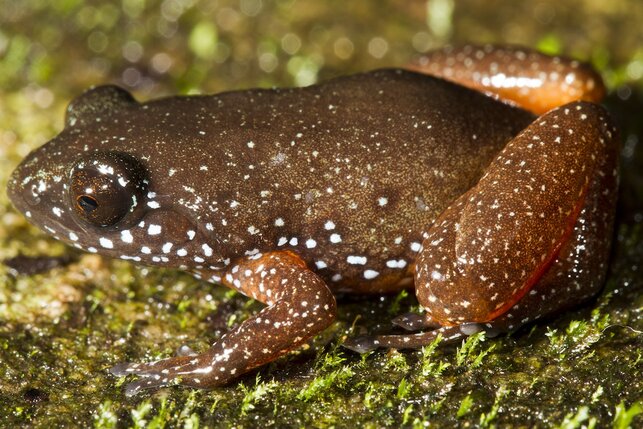Did you know about a 60-million-year old frog, Astrobatrachus kurichiyana, being discovered in Western Ghats by Kartik Shanker’s lab at Centre for Ecological Sciences in Indian Institute of Science in Bengaluru? Or that Nobel laureate C. V. Raman had a collection of over 600 diamonds of different types? Were you aware that Aamir Khan’s character in 3 Idiots was inspired by Sonam Wangchuk of Ladakh, who has more than 400 patents to his name? Or that Divya Mudappa has grown a rain forest in a tea estate in Valparai, Tamil Nadu? Or that the current director of Delhi’s IIT Ramgopal Rao has developed a sensor called e-nose that can detect presence of explosives?
The list of such pioneering Indians is endless. Know more about them this National Science Day (February 28) when Shweta Taneja’s two books – "They Found What? Stories of Daring Discoveries by Indian Scientists” and “They Made What? Stories of Ingenious Inventions by Indian Scientists” (Hachette India) are launched. The day is celebrated to coincide with the discovery of Raman Effect by C.V. Raman.

C.V. Raman (Image: Courtesy Hachette India)
Each book comprehensively details 10 Indian discoverers and inventors and their achievements. “Through the books I wanted to talk about scientists, living breathing and working hard in India, in different fields of chemistry, physics and biology,” remarks Taneja.
The WOW factor!
Initially the number of talented scientists overwhelmed Taneja. “I decided to keep true to the titles and the idea of wonder that I wanted to pursue when looking at scientists and their work. Which is why you have stories of Divya Mudappa who grew a rainforest in a tea garden, though there might be other ecologists doing fantastic work out there. Or of Sonam Wangchuk, who other than being a super inventor, also created giant ice stupas. All stories have one thing in common. They wow the reader with wonder.”

Sonam Wangchuk (Image courtesy: Twitter/@Wangchuk66)
Passion and dedication
What makes Taneja’s narrative engaging is that these 20 are ordinary people with extraordinary passion. “Each is obsessed with that little sub field of science that they’re working in.”
Citing examples from the books, she observes, “Manjula Reddy can’t get enough of looking at e.Coli cells to study their shape. Manindra Agrawal’s head is full of mathematical equations, which keep building as he walks, socializes or eats. The most joyous moment in Vijayalakshmi Ravindranath’s life was when she looked at a human brain through a microscope. She studies dementia and is a brain researcher and continues to be fascinated by the brain.”

J.C. Bose (Image: Courtesy Hachette India)
Featuring renowned names like C.V. Raman and J.C. Bose, the books also predominantly covers a number of young generation scientists. Raman, was the first Indian scientist to receive the Nobel Prize in 1930, while Bose’s work on radio signals and plant biology and his conviction that plants have feelings is still being studied. Both have been inspiration for aspiring scientists.
The books feature a large number of women scientists from varied fields. Vidita Vaidya after years of research has built models of how our brains are affected by stress, sadness, grief, trauma, and mental illness, experienced as children. Rama Govindarajan was awarded the prestigious Shanti Swarup Bhatnagar award for her work on exploring water droplets in cloud.
“I consciously decided to bring more gender equality into the book. Since I was writing for kids, I hopefully did my bit by highlighting more women scientists and their work, so the children, could re-imagine the idea of a scientist as not someone who is old, male, and has a halo of white hair (thank you, Einstein), but someone who is of either gender, young, energetic and someone who is curious and creative,” avers Taneja.

Snow Stupa (Image courtesy: Twitter/The Weather Channel India @ weatherindia)
Engagement and entertainment
The books are wonderful read for kids and grown-up alike as they are suffused with nuggets of information, humour and several activities. We come to know that Raman was an absent-minded professor who addressed a gathering wearing one sandal and once reached the lab without shirt or coat on! There are Interesting aspects about bacteria, how ecologists work, working of a brain, accidental discoveries, etc. in the narrative.

Shweta Taneja
“All these elements weave a sense of engagement and entertainment into the book which is essential when you’re writing for kids who have the attention span of a bee. Batty Cat adds a much needed laugh, Foxy Facts’ primness makes sure you get facts about a field, but get entertained too. Activities and boxes in each of the chapter are nuggets of the larger field the scientist is working in, but also curious things I found in my research which I wanted to share with my readers. Horrible Haikus, are horrid wordplays on each story,” says Taneja.
Taneja simple language and straight style make these books easy to read while invoking inquisitiveness among readers of all ages. This curiosity which is natural among children, needs to be helped by adults. Hopefully, books like this, will spur scientific temper in the country and make it self-reliant in all spheres of life.




















